Jet lag is an unavoidable part of any travel ritual. Those who travel together must learn to cope with it. We spent a number of years taking trips before we had children. Jet lag wasn’t so bad then. We could stay up late and sleep in as desired. It was only a minor inconvenience. We were in for quite a surprise when we had our twins.
We started traveling with our girls shortly after they were out of the womb. We started by taking a couple of road trips with only a 1 time zone difference. This didn’t require any significant change to our schedule. Going into our first trip abroad, we weren’t overconfident. We were simply clueless as to what obstacles lay ahead.
We flew from the US to Prague when our girls were 4 months old. The girls were great on the flight. We were exhausted by the time we arrived at our rental apartment. The girls were put to bed in the hope that we could get some sleep of our own. We were caught completely unaware when our precious little bundles spent the next 2 nights crying incessantly. Cuddling? Crying. Toys? Crying. Singing? Crying. Feeds? A brief respite followed by… crying. No matter what we tried, the response was the same. Slowly the twins were able to acclimate themselves during the trip without much help from us. Everyone was exhausted. We had clearly underestimated jet lag with twins.
Despite the rough start, we continued to travel. We have battled jet lag on 6 different continents and have picked up a few tricks along the way. While jet lag initially appeared an unavoidable nightmare, we discovered a number of ways we could ease the transition for ourselves and our kids. We hope our wisdom earned through crying, tears and sleepless nights will be useful to others.
TIPS TO BEAT JET LAG WITH TWIN BABIES/TODDLERS
A. Getting there:
1. Get the right seat for babies on long haul flights. Take advantage of the bassinets so your babies can sleep on the flight and have some space to play. For more information read our article about how to choose airline seats for lap babies.
2. Start adjusting the sleeping schedule in the direction of your destination’s time zone a week prior to departing. Whether you put them to bed earlier or later depends on which direction you are going. As we tend to take many long haul flights, the goal isn’t usually to get them on the destination schedule (as this is rarely possible). Rather, we are trying to time it so they will sleep for most of the long haul flight. This serves multiple purposes. It makes the flight easier for the whole family, allows the parents to get a bit of sleep on the plane and it shortens the duration of jet lag after your arrival by getting your twins a couple of hours closer to the destination schedule before you even leave.
Of course, this means that their whole day schedule is going to change. You can’t really predict how your twins will respond when you start adjusting their bedtime. This depends on your twins, their ages and your schedule. Sometimes you have to add or subtract naps to keep them from waking up at 4am or sleeping until noon. There is bit of trial and error involved. You know they will need the same total hours of sleep each day. Use this to anticipate necessary changes to their napping routine.
Let’s give an example. Malaysia is 14 hours ahead of our home in the US and the girls normally go to bed at 8pm. Our flight departing to Asia from Los Angeles (LAX) leaves at midnight. Roughly a week before our departure we start putting our toddler twins to sleep one hour later than their normal bedtime hours (9pm) for 2 nights in the row, then 10pm for 2 nights and 11 pm for one night and so on. To make this possible we might add an extra 1 hour nap around 6pm. On the day of travel, the girls are able to stay up until we board the long haul flight on which they sleep 8-9 hours. It sounds crazy but it works!
3. Relax the routine while en route. We are hardcore advocates for keeping our twins on a routine. That said, even we realize when traveling longer than 24 hours door to door that we have to throw the routine out the window. Long haul sleep aside, we let our girls determine their schedule during the trip. As babies we would keep them on an every 3 hours feed/wake/sleep cycle through the trip until bedtime at destination. As toddlers we would offer food and snacks every few hours, but let them determine when they needed to nap. We don’t let them take a nap longer than 2 hours, but otherwise let them go on autopilot.
B. At your destination:
1. No aggressive sightseeing plans on arrival. Try to get settled first! Limit sightseeing to an hour or two during the first (full) day, get some things from the local supermarket and spend some time at local playgrounds. Keeping your kids active will help them to stay awake when their bodies would otherwise tell them to be asleep. Don’t sign up for a long day tour right after your arrival. Take your time.
2. Keep your twins on the same schedule. They should be eating, sleeping, and playing at the same time. We are firm believers that keeping twins on the same routine makes life easier for everybody. Every time we travel, our girls tend toward different schedules unless we help keep them together.
3. Keep your twins (and yourselves!) awake as much as possible during daylight hours. Open all the curtains, play some music, turn on the TV, make breakfast or go to the nearest cafe. Get outside in the sunlight whenever possible. Daylight is a powerful stimulus for regulating biological clocks. Staying indoors worsens jet lag.
Babies normally have 3 to 4 hour eat/play/sleep cycles during the day. Try to re-establish this cycle in the new time zone. You will likely have to wake them early from a nap or two when their brain is telling them it’s bedtime. Play with your babies to keep them awake. Don’t leave them in the stroller. Let them crawl on the picnic blanket or hang out at the garden on a beautiful sunny day. Let them play with stimulating toys such as Baby Einstein Take Along Tunes Musical Toy. Only give them the pacifier or bottle at nap/feeding times.
It is much easier to keep toddlers awake. This is the time to explore new playgrounds, theme parks and play centers while soaking up the sun. A few hours before bedtime, find a place for them to play in a park or playground so they get extra tired. The more tired they are the better chance their bodies will tell them it’s night time not nap time!
4. Don’t go back to your rental for nap time(s). This should apply to the entire trip, but especially with jet lag. Your kiddos are extra tired and should have no trouble falling asleep in a reclined double stroller. Cover the stroller with a blanket to create privacy and to make it dark. If you go back to your rental, the temptation will be strong for YOU to take a nap prolonging your own jet lag. Minimizing time spent in your rental maximizes your time to explore.
On our Italian road trip when the girls were almost 2, we took advantage of day trips so the twins could nap together for 60-90 minutes while we were driving to a destination. The plan worked great and kept them on the same schedule! We didn’t have to put them down for naps. We would give them a bottle in the car, they would nap after drinking and we would get them up at the new destination. We were able to get in many day trips (2500 miles worth) in 2 weeks this way!
5. Limit length of daytime naps.Your twins will want to take long naps around their normal bedtime. When traveling, this is often during the middle of the day. Resist the temptation to let them “catch up” on sleep this way. It will only delay their adjustment to the destination schedule. More importantly, it will keep you up at night! Don’t allow them to sleep longer than 60-90 minutes at a time during the day, but allow them to take as many naps as needed. Of course, try to keep them up a number of hours prior to bedtime. They need to learn bedtime is not nap time!
6. Keep the bedtime routine the same as at home.Try to keep their bedtime routine as close to normal as possible. These are very strong cues that help children understand this is their new bedtime. Bring their favorite pillow, stuffed animal and blanket to ease the feeling of being in a new environment. As babies they had their swaddling blankets. As toddlers they never travel without their teddy bears and blankets. Keeping the bedtime routine consistent will ease the transition to the new schedule.
7. Split nights with your partner.Your twins will wake up at night the first few nights. Plan for it. We split the nights in half while we are transitioning to the new schedule. One parent covers the first half while the other covers the second. This allows both parents to get much needed sleep.
If your kids normally sleep 10 hours per night, each parent should cover 5 hours. The late shift parent goes to bed early (in case it’s a hard night) while the early shift parent stays up for a while. To be clear, we are not advocating that you stay awake the entire “shift.” This just decides WHO will get up if one of the kiddos (or both) need some attention in the middle of the night (they will). The twins should be close enough for you to easily hear their cries, but not in the same room as this will wake both parents up. Use earplugs when you are not “on shift.”
8. Parents should take turns feeding and changing babies at night. Realize that babies’ metabolism also needs to adjust to the new routine. Your children may sleep through the night at home but they will wake up in the middle of the night hungry when jet lagged. Hungry babies are not sleeping babies! Give them full feeds (no snacking!) when they awaken at night. This gets them sleepy and helps prevent further awakenings. Early on, I breast pumped so my husband could help with night feeds. Later, we pre-measured formula into bottles before bed (just add water when you get up). If only 1 baby wakes up, we suggest you feed and change them both “dream feeding” the second twin. Take turns with your partner and keep little bellies full those first few nights when traveling. (Incorporate feeds into the “shifts” above- eg “first shift” gives a feed/dream feed before going to bed).
9. Encourage quiet time when they awaken at night. They will wake up during the night. Their bodies tell them it is nap time, not bedtime. Try to minimize stimulation and interaction. Keep the lights off or turned down low. Speak softly to them. Let them play quietly with books, blocks and other less stimulating toys. This isn’t the time to turn on the ipad/TV or toys with lights and loud sounds. This is quiet time. Feed and change them. Eventually they will get tired and join you to lay down for a cuddle or be ready for the crib.
10. Try sleeping with your twins. Our girls never sleep with us at home. Since they were toddlers, we occasionally bend that rule when fighting jet lag. This generally happens when the girls wake up in the middle of the night and have difficulty getting back to sleep. What to do when they are both awake, playful and clearly ready for mischief at 3am? It is very difficult for them to get back to sleep on their own. The parent “on shift” will get up, spend “quiet time” with them and then encourage them to go back to sleep. To do this, we sometimes lay down with them on their bed (often the floor or a rollaway) until everyone falls back to sleep. One parent sleeps with them while the other parent recharges for shift change.
11. Make sure that their sleeping room is as dark and quiet as possible.This helps to reinforce to them that it is nighttime not nap time. If your rental is noisy (street noise, etc) play lullabies on your phone or other “white noise” to help create an environment conducive to sleep.
C. Returning home:
Unfortunately, jet lag is a 2 way street. You pay the price on both ends of the trip. Be ready to flip back when you get home.
1. Plan your schedule for the return trip. Similar to the departure, plan the return to maximize long haul sleep time. Start transition 1-2 days before you leave. Make sure that you bring their favorite blanket and teddy bears to help them fall asleep in the plane.
2. Parents, don’t rush back to work. It’s great to maximize your travel time. Just realize the kids (and you! ) will likely wake up the first few nights (and drag during the days) after your return. Leave at least a couple of days to recuperate and transition if you can.
3. Vacation is over. Our kids have a number of perks while on vacation. There are fewer toys and crafts to keep them busy so we allow more liberal access to tablets, TV, and movies. Once we get home the girls are back in their normal environment with all their things close at hand. We know well the local parks and playgrounds. We restart home rules immediately on return.
4. Get outdoors during the day! Same as above. Get out and keep yourselves busy. There are usually plenty of errands to run. Get some groceries, go to the park, meet up with friends for lunch to discuss the trip. Keep on the move to get those internal clocks reset.
5. Resume normal feeding and sleep schedules. Yes, the kids will likely wake up those first couple of nights. Their metabolisms will need to readjust (again) and you will likely have to have “quiet time” and give extra night feeds (again) to get them back on schedule. That’s okay. Use the same techniques you did when traveling. Now in their familiar surroundings, your twins will hopefully adjust more quickly and easily than they did on the trip.
6. Minimize social gatherings for a few days. There will be plenty of time to catch up with friends and family. You and your kids will be crankier than normal while resetting your circadian rhythms. Small, brief gatherings are likely fine. Just realize your little ones might not be on their best behavior during these jet lag transitions.
Now get out there and conquer jet lag with twins!
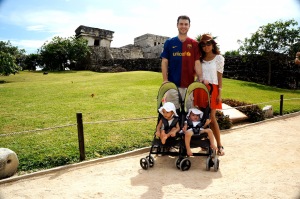
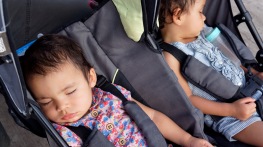
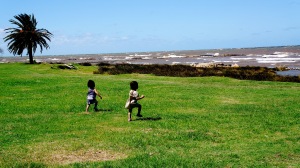
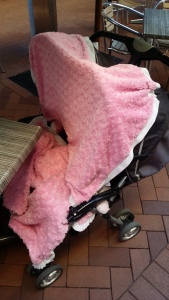

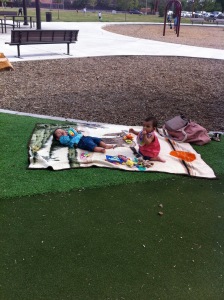

We followed many of the same rules with our twins. Night flights and straight into a regular routine in whatever time zone you landed in. Now they are 9 and champion travellers. Very easily settling in without jet lag.
That gives me hope. Ours are still toddlers and adjusting on our last trip was pretty brutal. I’m not going to give up though!